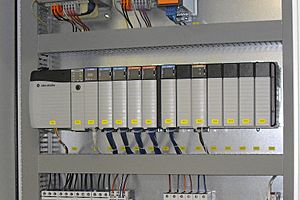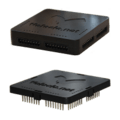Programmable logic controller facts for kids
A programmable logic controller (PLC) is like a special computer built to control machines and processes in factories and other big industries. It helps make things work automatically, without a person having to do every step by hand.
PLCs are used in almost all heavy industries. Think of places like car factories, power plants, or even water treatment facilities. They are perfect for jobs that need many steps to happen in a specific order, over and over again.
How PLCs Work
A PLC has special connections for inputs and outputs.
- Inputs are like the PLC's eyes and ears. They get information from sensors. For example, a sensor might tell the PLC if a door is open, if a bottle is full, or if a machine part is in the right place.
- Outputs are like the PLC's hands and voice. They send commands to machines. For example, the PLC might tell a motor to start, a light to turn on, or a robotic arm to move.
The "logic" inside a PLC is a set of rules or instructions that tell it what to do. Imagine a recipe: "If the oven is hot (input), then bake the cookies (output)." A PLC's logic is programmed by people to control machines exactly how they want. This allows factories to create highly specialized systems for their needs.
Where PLCs Are Used
PLCs are super important for automation. They help make sure that machines work safely, efficiently, and precisely.
- In car factories, PLCs control the robots that weld parts together or paint the cars.
- In food processing plants, they manage the mixing, cooking, and packaging of food.
- They also control traffic lights, amusement park rides, and even the systems that manage heating and cooling in large buildings.
PLCs are designed to be very tough and reliable. They can work in harsh environments, like hot or dusty factories, and they are built to last a long time. They are a key part of modern manufacturing and help make many of the products we use every day.
Images for kids
-
Control panel with PLC (grey elements in the center). The unit consists of separate elements, from left to right; power supply, controller, relay units for in- and output
See also
 In Spanish: Controlador lógico programable para niños
In Spanish: Controlador lógico programable para niños









